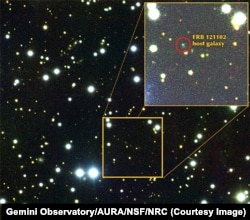The idea may be a little out of this world.
Ten years ago, scientists started noticing very brief, but powerful radio bursts coming from outer space.
Called fast radio bursts, or FRBs, they have been identified as millisecond-long bursts of radio emission. Scientists believe these emissions were made in a group of stars billions of light years away from Earth.
A new theory says the radio bursts may be evidence of highly developed alien life. A paper describing the theory was published this month in The Astrophysical Journal Letters.
The bursts cannot be seen with the human eye, but were observed by very large radio telescopes.
Many scientists believe that these powerful flashes may be related to the collapse of a massive star. But scientist Avi Loeb says researchers have yet to confirm any natural cause of the emissions.
Loeb is chair of Harvard University’s Astronomy Department and works at the Harvard-Smithsonian Center for Astrophysics.
He believes the bursts might be coming from powerful equipment, like a transmitter used on Earth to broadcast radio or television signals. He thinks the device could be as big as a planet and have enough power to send large spaceships great distances.
Light Powered Spaceships
While noting this is just “speculation,” Loeb told VOA what he suspects might be producing the fast radio bursts. He says, imagine a spacecraft moving like a sailboat, powered by light from the huge planet-sized transmitter.
“If you have a sailboat, the wind is pushing the sail, and the sail carries the boat along with it. You can imagine doing exactly the same thing with light. If you bounce light off a sail, you could push a spacecraft. And in principal because the spacecraft doesn’t carry its own fuel, you can push it all the way to the speed of light. At very high speeds.”
Loeb says it could be created by alien life forms belonging to a highly developed civilization.
He thinks the powerful bursts could be a sign of “leakage” — when light hitting the sail moves just past the edge of the sail. It shows up on Earth as a very bright, fast-moving radio wave.
"And the idea is that the beam of light that is being used to push the sail is leaking. We see leakage of that radiation and if the beam is powerful enough we could see it from a great distance and because the beam is sweeping across the sky, we would see it as a flash of light, as a burst of radio waves, the way these fast radio bursts appear."
Alien Threat?
If there are aliens — life outside our planet — are they a threat?
Loeb does not think so. If they do exist, they are “great distances” from us, he notes, “so there is no danger for us directly.”
The bursts were first observed in 2007. Since then, a total of 18 have been identified using very large radio telescopes.
Some of the researchers have been at the National Radio Astronomy Observatory (NRAO) in the American state of New Mexico. They identified where one burst came from -- a dwarf galaxy more than three billion light-years from Earth.
Sarah Burke-Spolaor teaches physics and astronomy at West Virginia University. She reported on the discovery earlier this year in two journals: Nature and Astrophysical Journal Letters.
Burke-Spolaor says the fast radio burst was first discovered in November of 2012 at the Arecibo Observatory in Puerto Rico. The NRAO radio telescope later helped to identify where the FRB came from. What makes this emission different is that it is the only one to keep sending bursts — about 200 times, so far.
Burke-Spolaor says there are “many ideas about what FRBS are.” She says “the leading theory … is that these are related to neutron stars in other galaxies.” They could also come from black holes – areas with a gravitational field so intense that no matter or radiation can escape.
She describes Avi Loeb as an “out of the box thinker.” She says his theories have an important job: they “make us (scientists) reconsider our assumptions and what we know and don’t know.”
She adds, “it doesn’t mean the theory is anywhere near right, but we don’t have enough evidence to rule it out.”
Where did Loeb get his theory?
And where did Loeb get the idea that the fast radio bursts come from light pushing a spaceship?
Loeb leads a team developing technology to send spacecraft to a planet called Proxima b. The project is called Breakthrough Starshot. He and the team are developing thousands of small spacecraft with sails. They want to use laser beams to push those sails forward.
That got him thinking.
“The fact that we are starting to think about propelling a spaceship, a spacecraft with light made me think about the possible signals that we could detect from the sky from a civilization that is using this technology.”
For now, Loeb’s idea is just a theory. He and others say it will take more information to know if his theory is right.
I’m Anne Ball.
Anne Ball reported this story from VOA Learning English with information from VOA. George Grow was the editor. We want to hear from you. Write to us in the Comments Section. And find us on our Facebook page.
See how well you understand the story by taking this reading quiz.
______________________________________________________________
Words in This Story
burst – n. a short period of producing or doing something that begins suddenly
emission – n. the act of producing or sending out something (such as energy or gas) from a source
alien – n. a creature that comes from somewhere other than the planet Earth
speculation – n. ideas or guesses about something that is not known
dwarf – adj. smaller than normal size
assumption – n. something that is believed to be true or probably true but that is not known to be true
detect – v. to discover or notice the presence of (something that is hidden or hard to see, hear, taste, etc.)












